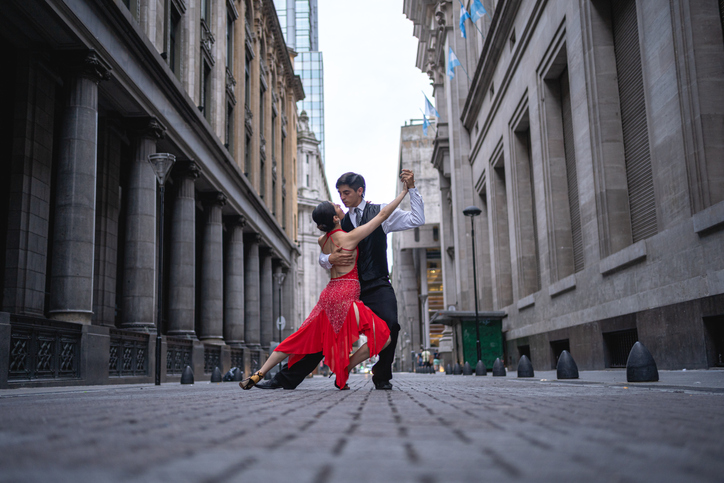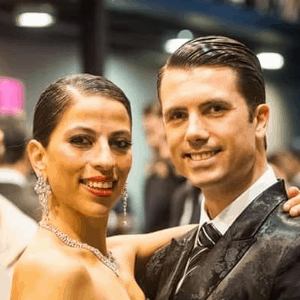Tango musicality: an easy guide and 3 tips

When it comes to tango musicality, we often compare a dancer with musicality and one without to a normal car and a racing car. The normal car is fine for your daily needs, but the racing car’s components are all of the highest quality.
I believe that dancers who investigate tango musicality become special.
These are the people that others in the milonga want to dance with. The potential partners think: “The rest of the people are OK, I will have fun with them, and I will probably enjoy the dance, but with that person, I will have an amazing experience. That person is never boring.”
Let’s explore together learning tango musicality:
- The 5 layers of tango musicality
- How to discover your tango musicality
- Three practical tips
The 5 layers of musicality
In musicality, there are 5 layers: Rhythm, Phrase, Feeling of the music, Lyrics, and Yourself.
Rhythm
The first and most obvious layer of tango musicality is the rhythm. The rhythm is like the heartbeat; it is always there.
Musicality is how you choose to express this existence of the rhythm. It is like the sea. You are at the beach, the waves are there, and you want to play with the waves. You look at the waves, and you say: one, two, three, go! And you enter the water, wanting to reach the wave at the peak.
The rhythm, just like the waves, is there. It’s your choice to decide how to play with it.

Phrase
Then, comes the phrase. Which beat starts the phrase of the music, and which beat finishes it? You need to be aware of that. Then you have the different instruments that you can interpret, so you must be able to hear the violin, the bandoneon, and the bass underneath.
Feeling of the music
Going deeper, you have to feel the general feeling of the music, the temperament. Is it sweet, strong, sad, fast, staccato, something dark or light? To understand tango musicality you have to feel the taste of the music.

Lyrics
Next, you can focus on the lyrics, which may make you interpret the music in a different way, based on the story they tell.
Yourself
Finally, you have to tune into yourself: how do you want to interpret something? Maybe the music says: “love – you have to interpret love,” but you interpret love differently from everyone else. You have to hear yourself when expressing tango musicality.
We mentioned “love” so let’s go a bit deeper. The same concept is different at different ages. We don’t mean the age of the recording, but your age, or rather the age that you choose to experience when you dance. You fall in love differently when you are 18, when you are 40, when you are 80.
Discovering your tango musicality
Women sometimes lack musicality because they get stressed by thinking that they have to be perfect in relation to the music and the following. But if you breathe the music, everything becomes harmonious. Sometimes we don’t lack musicality; we lack freedom or the ability to be at peace with what is going on inside us.
Sometimes both leaders and followers feel imprisoned by the music. Music should be free. It should be like a carpet, which I have to step on, but in whatever way I like.
Let’s see how you can do that.

Discovering your musical freedom
An eye-opening mental exercise to explore tango musicality
- First, listen to the music. Don’t dance. Listen.
- Then try to imagine it like a movie. The movie has a plot. You have to see where the climax is, where the introduction is. This is the general image.
- Then, little by little, you focus on the phrases. If you think “where do I have to put the figure, the giro?” you get lost because you can put it anywhere. Forget about that. Just be part of the movie that the music dictates, listen calmly, and lose yourself within it.
Then, when you go to the dance floor, you will be more prepared. You have seen the trailer, and you have seen the movie. You have fewer things to put in order. This makes everything easier.

Practical tips to improve your musicality
Tango Musicality Tip #1
If you are a beginner, simply try to clap to the music.
Tango Musicality Tip #2
If you have danced for a few years, try to listen and sing the different instruments. For example, listen to the song and try to sing the piano only. Imagine you are the pianist, but play the piano with your voice. Then do the same with the violin, and the bandoneon. Finally, try to find the secret notes they play, the ones that can barely be heard.

Tango Musicality Tip #3
For the more visual students, imagine that you are listening to the music live. You don’t just listen to the violin; you actually see the violinist and what he is doing. Is he smiling, is he lifting a shoulder, is he closing his eyes?
We, the dancers, are also instruments, and we have to express ourselves through the music. If you bring to your mind how the musician is moving when he plays, and you have an idea of how he feels, you can more easily see if you should be happy, nostalgic, etc.
A final note (pun intended)
Musicality is like breathing; it has to be natural. When you get stressed, your breathing is not good, so at that moment, you have to think of your breathing. The same thing happens with the music. If you get stressed, then your musicality suffers. But, it is not because you don’t listen to the music, but because your body gets blocked.
Keep that in mind, because sometimes it is not that you cannot listen to the music; it is that you can’t listen to YOUR body, YOUR breathing, YOUR emotion.
If you listen to your emotions, your tango musicality improves immediately.
Vaggelis Hatzopoulos & Marianna Koutandou – from the book Tango Tips by the Maestros

Vaggelis Hatzopoulos & Marianna Koutandou – Greece
European Tango Champions, Directors of the Academia del Tango in Greece, and Finalists of the World Tango Championship. For us, Tango is a metaphor for an empowered life. With our dance and teaching we aim to create a change in the way people experience and understand life, and help them experience tango’s essence: the ability to not be perfect and at the same time laugh about it, to understand deeper the person you have in front of you, and to make mistakes together, learn from them, and then keep moving and growing.
